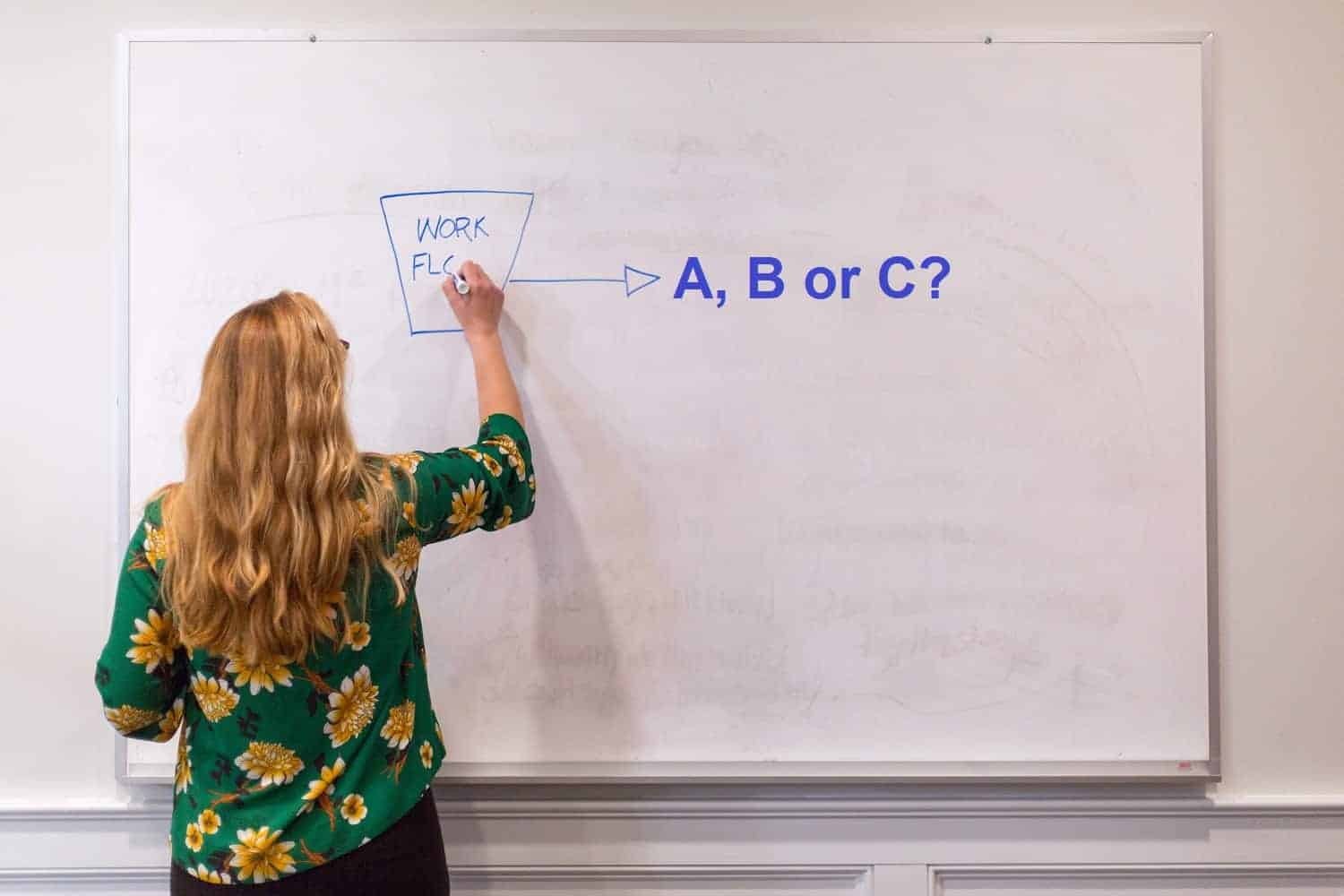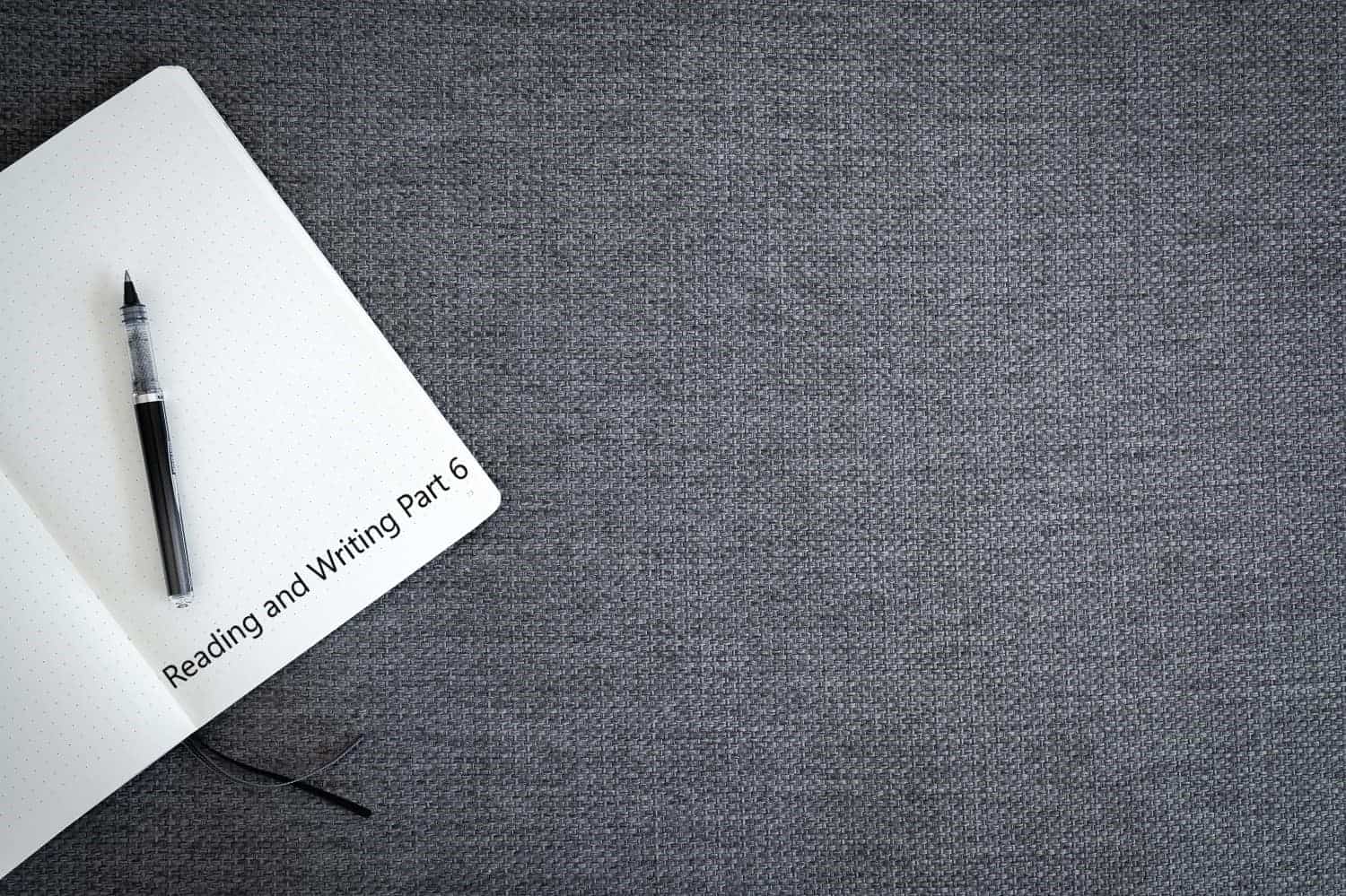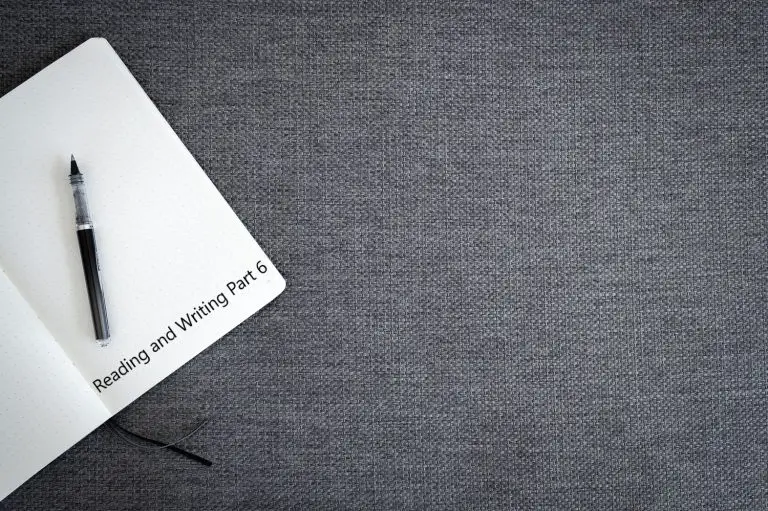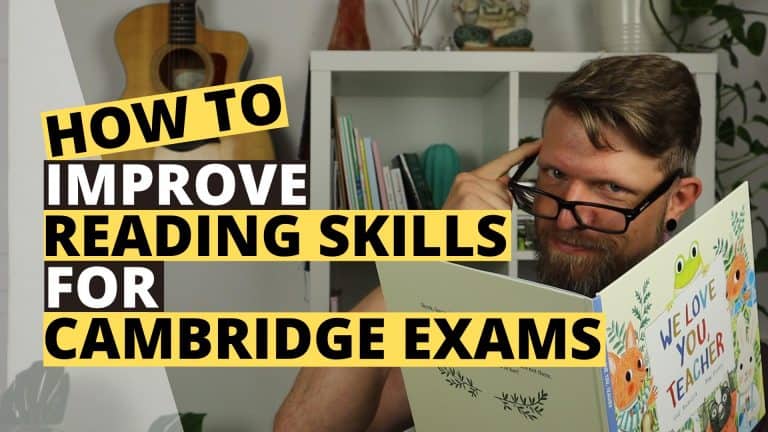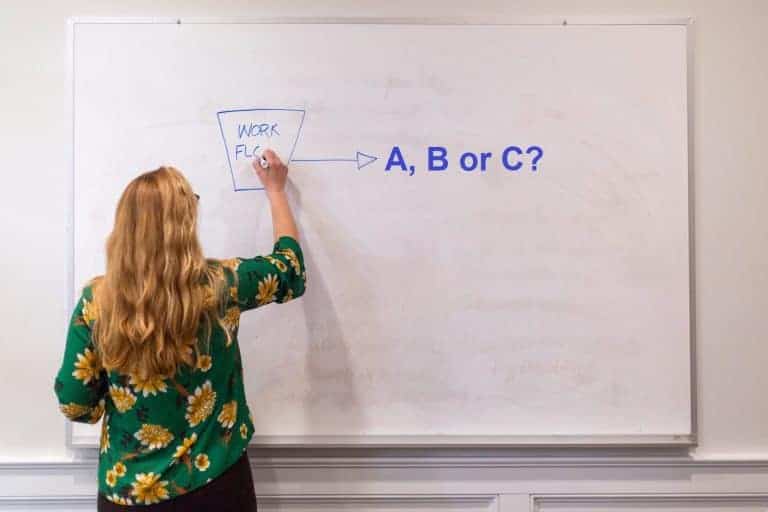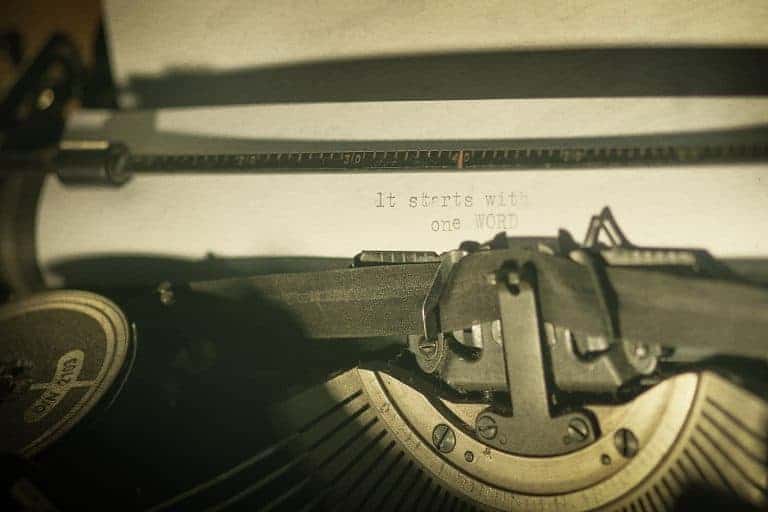Reading and Writing Part 5
In this article, I’m going to teach you all the important things you should know about A2 Key Reading and Writing Part 5. We are going to look at a typical task, some of the most common problems and the best tips and strategies so you can get high marks and save time.
Cambridge A2 Key is a big test with different parts and a lot of different tasks. Because of that I recommend reading one of my other articles. There, you can learn more about the whole exam and get some very useful information. If that sounds interesting to you, please click the link below.
>>> Cambridge A2 Key explained <<<
What do you have to do in Part 5?
Open cloze – You have to read a shorter email (and sometimes the reply to this email too) with a total of six gaps. For each gap, you need to think of the correct word to fill in. There are no possible answer options for you in this task.
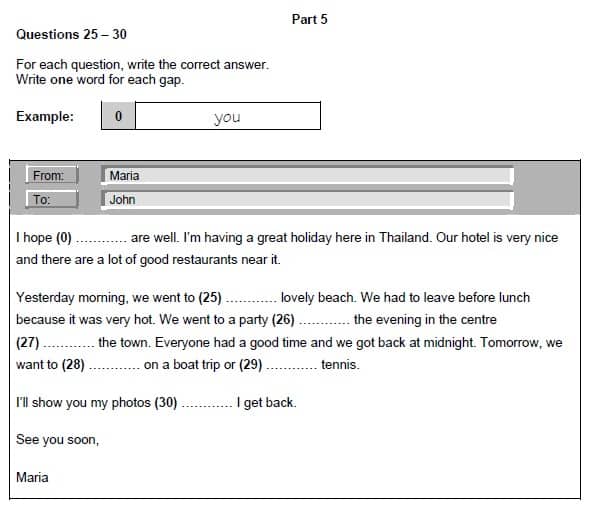
Above you can see an example task of Reading and Writing Part 5. There is always and example (0) that you don’t have to do and the six gaps with the numbers 25-30.
Part 5 always tests your vocabulary. You have to show that you know combinations of words, for example, compound nouns (football player), collocations (do your homework, not make your homework) and some grammar words (articles, prepositions, etc.)
When you finish the task, you must always write all your answers onto an extra answer sheet. You receive this sheet at the beginning of the test.
Because Cambridge A2 Key Reading and Writing has seven parts (five for Reading and two for Writing) it might be a good idea to learn a little bit more about this exam paper. The seven parts are all very different so it is important that you know how each part works.
You can follow the link below to find out a little bit more about A2 Key Reading and Writing before you continue with this article.
[elementor-template id=”1962″]
>>> Everything you need to know about A2 Key Reading and Writing <<<
What is difficult about Part 5?
Every part in the Reading and Writing test is different and with each task there are some typical problems that I can often see with my students in Part 5.
Language problems
In Reading and Writing Part 5, you have to show how good your grammar and vocabulary are. You need to know small things, for example, articles, prepositions and collocations. Unfortunately, many students don’t know these things very well and lose marks in the exam because of it.
Luckily, there are some things that you can do in order to avoid these problems and in the next section about tips and strategies I’m going to show you how it works.
Time management
In A2 Key Reading and Writing, there are seven tasks and you only have 60 minutes to finish everything. On top of that, you have to transfer all your answers onto an extra answer sheet and this is also included in those 60 minutes.
All together, you have around 8 minutes for each task. This is definitely not a lot of time and it can become very frustrating and stressful.
Tips and strategies for Part 5
Now that we know some of the most common problems with Reading and Writing Part 5, let’s have a look at the solutions and what you can do you save time and get high marks.
General tips
My first tip for everyone who thinks that their grammar and vocabulary are not that great is to start a reading and listening habit. If you read and listen to things in English regularly (of course something you can understand), you can improve your English very quickly.
I always recommend graded readers or podcasts because there are so many of them for every level and you should be able to find something that you like, and with just 5-10 minutes per day you can make a big difference.
Another great way to improve is to take English classes at a local language school. Working with others is often more fun and having a teacher in the room with you or online can be very helpful. There are schools all over the world that offer good-quality Cambridge preparation classes and you can look HERE to find a school close to you.
Last but not least, think about the order of the tasks in Reading and Writing. You don’t have to follow the order in the exam, but you can, for example, start with the writing tasks (Parts 6 and 7) or the grammar and vocabulary tasks (Parts 4 and 5). Think about your preferences and decide how you want to do it.
Follow a plan
Reading and Writing Part 5 has specific rules and it is different from the other tasks so you need to know how it works, what you have to be careful with and how you should answer the questions.
Having a plan can help you save time and feel more confident and relaxed because you always know what to do next.
In Part 5, a good plan looks like this:
- Read the text quickly
- Analyse the gaps
- Fill in the gaps
- Read the text again
This might look very simple, but let’s have a look at the different steps in more detail.
Read the text quickly
This first step is important because you want to know the topic of the text and what it is talking about. don’t look at the gaps yet, but simply get a general idea. This will help you when you look at the gaps and try to fill them in.
Also, try to read the text as quickly as possible because you want to save as much time as possible. Again, QUICKLY is the keyword here.
Analyse the gaps
The second step is when we really start the work. Look at the words that come before and after the gaps and look for words that might help you with your decision.
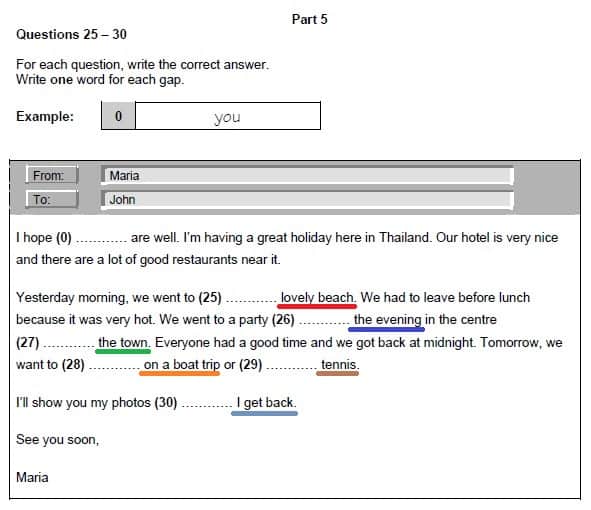
In the example from before, I underlined the keywords that will help us with our decision. For example, in gap 25 there is a noun phrase (adjective + noun). What do we usually use before a noun or noun phrase? In gap 26, there is the time expression ‘…the evening’. What preposition do we use with that – at, in or on?
Look at the other gaps and think about what kind of (grammar) word is missing to complete the underlined parts.
Fill in the gaps
After we have thought about the type of word we are looking for, we have to choose one word to put in each gap.
Remember gap 25 and my question? Do you know the answer? The missing word in this example is ‘a’ because before a noun phrase we typically use an article (a/an/the). Here, we use ‘a’ because the text talks about the beach for the first time.
In gap 26, I asked you for the correct preposition. Which one is it – at, in or on? If you found it, congratulations. The correct phrase is ‘in the evening’.
Have you also thought about the other gaps? The correct answers are 27:of, 28: go, 29: play, 30: when/once
Read the text again
When you finish with all the gaps, you should always read the text one more time to check your answers.
We sometimes focus too much on the gaps and forget to check if the sentences make sense, but when you read everything again, you can catch your mistakes and correct them if you have to.
Summary
In this article, you have learned about Reading and Writing Part 5. We looked at a typical task with all the common problems and at how you can go through the task in the best way.
Now, take my advice and start practising. Work on your language skills and your exam skills. Don’t wait until it is too late and I hope my article will help you with that.
Lots of love,
Teacher Phill 🙂





